Class 10 ICSE Physics Refraction through Plane Surface Boards Questions
Here we provide Class 10 physics important notes,board questions and predicted questions with Answers for chapter Refraction through Plane Surface. These important notes,board questions and predicted questions are based on ICSE board curriculum and correspond to the most recent Class 10 physics syllabus. By practising these Class 10 materials, students will be able to quickly review all of the ideas covered in the chapter and prepare for the Class 10 Board examinations.
Class 10 ICSE Refraction through Plane Surface Boards Questions
Refraction through Plane Surface Boards Questions
2016
Q1
A ray of light falls normally on a rectangular glass slab. Draw a ray diagram showing the path of
the ray till it emerges out of the slab.
solutions
solutions

Q2
Complete the path of the monochromatic light ray AB incident on the surface PQ of the equilateral
glass prism PQR till it emerges out of the prism clue to refraction.
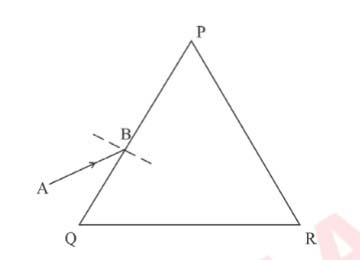
solutions

solutions

Q3
A diver in water looks obliquely at an object AB in air.
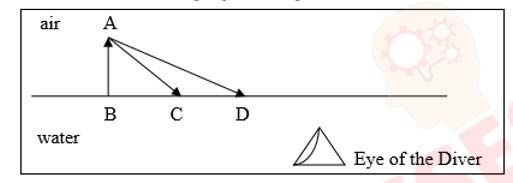
(i) Does the object appear taller, shorter or of the same size to the diver?
(ii) Show the path of two rays AC & AD starting from the tip of the object as it travels towards the diver in water and hence obtain the image of the object.
solutions

(i) Does the object appear taller, shorter or of the same size to the diver?
(ii) Show the path of two rays AC & AD starting from the tip of the object as it travels towards the diver in water and hence obtain the image of the object.
solutions

2017
Q4
A pond appears to be 2.7 m deep. If the refractive index of water is 4/3. Find the actual depth of
the pond.
solutions
solutions

Q5
The wave lengths for the light of red and blue colours are nearly 7.8 x 10-7 m and 4.8 x
10-7 m respectively.
(i) Which colour has the greater speed in a vacuum?
(ii) Which colour has a greater speed in glass?
solutions
(i) Which colour has the greater speed in a vacuum?
(ii) Which colour has a greater speed in glass?
solutions

2018
Q6
Complete the path of the ray AB through the glass prism in PQR till it emerges out of the prism.
Given the critical angle of the glass as 42°.

solutions

solutions

Q7
(i) What is the relation between the refractive index of water with respect to air
(aμw) and the refractive index of air with respect to water
(wμa).
(ii) If the refractive index of water with respect to air (aμw) is 5/3. Calculate the refractive index of air with respect to water (wμa).
solutions

(ii) If the refractive index of water with respect to air (aμw) is 5/3. Calculate the refractive index of air with respect to water (wμa).
solutions


Q8
The diagram below shows a light source P embedded in a rectangular glass block ABCD of critical
angle 42°. Complete the path of the ray PQ till it emerges out of the block. [Write necessary
angles.]
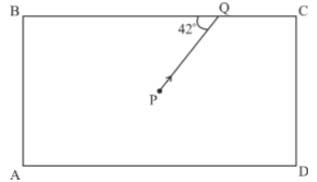
solutions

solutions

2019
Q9
How does the angle of deviation formed by a prism change with the increase in the angle of
incidence?
Draw a graph showing the variation in the angle of deviation with the angle of incidence at a prism
surface.
solutions
solutions

Q10
(i) State relation between the critical angle and the absolute refractive index of a medium
(ii) Which colour of light has higher critical angle ? red light or green light
solutions
(ii) Which colour of light has higher critical angle ? red light or green light
solutions

Q11
The following diagram shows a 60o, 30o, 90o glass prism of critical angle
42o copy the diagram and complete the path of incident ray emerging out of the prism
making the angle of incidence on each surface

solutions

solutions

Q12
A ray of light XY passes through a right angled isosceles prism as shown below
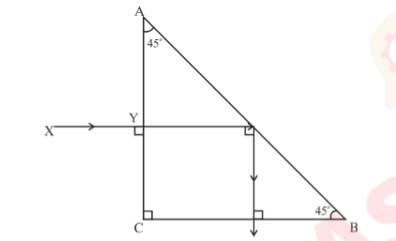
(i) What is the angle through which the incident ray deviates and emerges out of the prism ?
(ii) Name the instrument where this action of prism is put into use
(iii) Which Prince surface will behave as a mirror
solutions

(i) What is the angle through which the incident ray deviates and emerges out of the prism ?
(ii) Name the instrument where this action of prism is put into use
(iii) Which Prince surface will behave as a mirror
solutions

Q13
How is the refractive index of a material related to
(i) Real and apparent depth
(ii) Velocity of light in vacuum or air and velocity of light in a given medium ?
solutions

(i) Real and apparent depth
(ii) Velocity of light in vacuum or air and velocity of light in a given medium ?
solutions


Q14
State the condition required for total internal reflection of light to take place
solutions
solutions

Q15
Draw diagram to show the refraction of a monochromatic ray through prism when it suffers minimum
deviation
solutions

solutions


Q16
A ray of light travels from water to air shown in the diagram given below
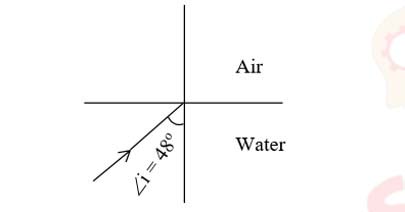
(i) Copy the diagram and complete the path of the ray given the critical angle for water is 48o
(ii) State the condition so that total internal reflection occurs in the above diagram
solutions

(i) Copy the diagram and complete the path of the ray given the critical angle for water is 48o
(ii) State the condition so that total internal reflection occurs in the above diagram
solutions

Q17
The diagram below shows a point source P inside a water container. Four rays A, B, C, D starting
from the source P are shown upto the water surface
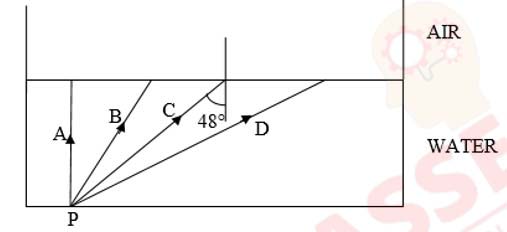
(i) Show in the diagram the path of these rays after shrinking the water surface. The critical angle for water air surface is 48o
(ii) Name the phenomena which the ray B and D and exhibit.
solutions

(i) Show in the diagram the path of these rays after shrinking the water surface. The critical angle for water air surface is 48o
(ii) Name the phenomena which the ray B and D and exhibit.
solutions

Q18
Copy the diagram given below and complete the path of the light ray till it emerges out of the
prison the critical angle of glass is 42o in your diagram mark the angles wherever
necessary
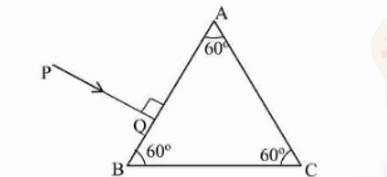
solutions

solutions

Q19
State the dependence of angle of deviation
(i) On the refractive index of the material of the prism
(ii) On the wavelength of light
solutions
(i) On the refractive index of the material of the prism
(ii) On the wavelength of light
solutions

Q20
(i) Write a relationship between angle of incidence and angle of reflection for a given pair of
media
(ii) When a ray of light enters from one medium to another having different optical densities it bends. Why does this phenomena occur ?
(iii) Write one condition where it does not bend when entering a medium of different optical density.
solutions

(ii) When a ray of light enters from one medium to another having different optical densities it bends. Why does this phenomena occur ?
(iii) Write one condition where it does not bend when entering a medium of different optical density.
solutions



Reach Us
SERVICES
- ACADEMIC
- ON-LINE PREPARATION
- FOUNDATION & CRASH COURSES
CONTACT
B-54, Krishna Bhawan, Parag Narain Road,
Near Butler Palace Colony Lucknow
Contact:+918081967119

Add a comment